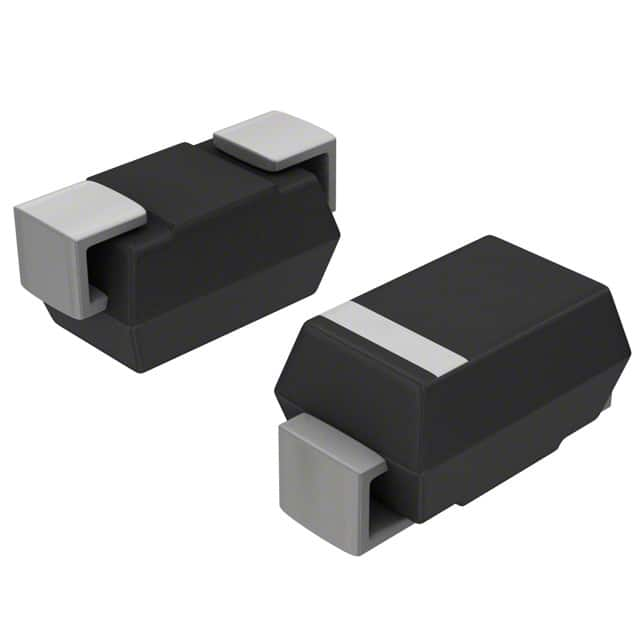MSMBJ13CAE3 Product Overview
Introduction
The MSMBJ13CAE3 belongs to the category of transient voltage suppressor diodes (TVS diodes) and is commonly used for protecting sensitive electronic components from voltage spikes and transients. This entry provides a comprehensive overview of the MSMBJ13CAE3, including its basic information, specifications, pin configuration, functional features, advantages and disadvantages, working principles, application field plans, and alternative models.
Basic Information Overview
- Category: Transient Voltage Suppressor Diode
- Use: Protection against voltage spikes and transients
- Characteristics: Fast response time, low clamping voltage, high surge current capability
- Package: SOD-123FL
- Essence: TVS diode for circuit protection
- Packaging/Quantity: Tape & Reel, 3000 units per reel
Specifications
- Peak Pulse Power: 600W
- Breakdown Voltage Range: 11V to 15V
- Operating Temperature Range: -55°C to +150°C
- RoHS Compliant: Yes
Detailed Pin Configuration
The MSMBJ13CAE3 TVS diode has a standard SOD-123FL package with two pins. Pin 1 is the anode, and pin 2 is the cathode.
Functional Features
- Fast response time to clamp transient voltages
- Low clamping voltage to protect downstream components
- High surge current capability for robust protection
Advantages and Disadvantages
Advantages
- Effective protection against voltage spikes
- Compact SOD-123FL package for space-constrained applications
- RoHS compliant for environmental considerations
Disadvantages
- Limited breakdown voltage range compared to some other TVS diodes
- May require additional components for comprehensive overvoltage protection
Working Principles
The MSMBJ13CAE3 operates by diverting excessive transient currents away from sensitive components in the circuit, thereby limiting the voltage across them. When a transient voltage exceeds the breakdown voltage of the diode, it conducts and shunts the excess energy to ground, protecting the downstream circuitry.
Detailed Application Field Plans
The MSMBJ13CAE3 is widely used in various electronic systems, including: - Consumer electronics - Telecommunication equipment - Industrial control systems - Automotive electronics - Power supplies
Detailed and Complete Alternative Models
Some alternative TVS diode models that can be considered as alternatives to the MSMBJ13CAE3 include: - SMAJ13A - P4SMAJ13A - SMBJ13A - SMCJ13A
In conclusion, the MSMBJ13CAE3 TVS diode offers effective transient voltage suppression and is suitable for a wide range of applications. Its compact package, high surge current capability, and RoHS compliance make it a popular choice for circuit protection.
Word count: 399
Lista 10 Vanliga frågor och svar relaterade till tillämpningen av MSMBJ13CAE3 i tekniska lösningar
What is MSMBJ13CAE3?
- MSMBJ13CAE3 is a surface mount transient voltage suppressor diode designed to protect sensitive electronics from voltage transients induced by lightning, inductive load switching, and electrostatic discharge.
What is the maximum working voltage of MSMBJ13CAE3?
- The maximum working voltage of MSMBJ13CAE3 is 13V.
What is the peak pulse current rating of MSMBJ13CAE3?
- The peak pulse current rating of MSMBJ13CAE3 is 30A.
What are the typical applications of MSMBJ13CAE3?
- MSMBJ13CAE3 is commonly used in telecommunication equipment, consumer electronics, industrial control systems, and automotive electronics for surge protection.
What is the clamping voltage of MSMBJ13CAE3?
- The clamping voltage of MSMBJ13CAE3 is typically 21.5V at 10A.
Is MSMBJ13CAE3 RoHS compliant?
- Yes, MSMBJ13CAE3 is compliant with the Restriction of Hazardous Substances (RoHS) directive.
What is the operating temperature range of MSMBJ13CAE3?
- The operating temperature range of MSMBJ13CAE3 is -55°C to 150°C.
Does MSMBJ13CAE3 require any special handling during assembly?
- MSMBJ13CAE3 should be handled using standard ESD precautions during assembly to prevent damage to the device.
Can MSMBJ13CAE3 be used for high-speed data lines?
- Yes, MSMBJ13CAE3 is suitable for protecting high-speed data lines such as USB, HDMI, and Ethernet interfaces.
What package type does MSMBJ13CAE3 come in?
- MSMBJ13CAE3 is available in a compact SMB package for easy surface mount assembly onto PCBs.


